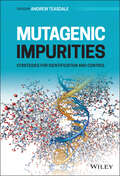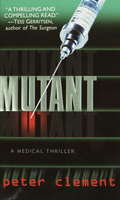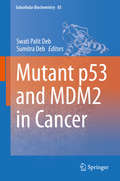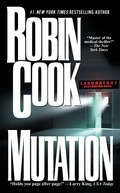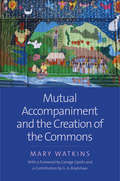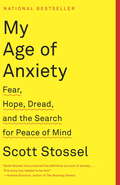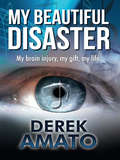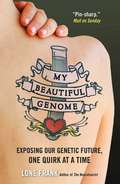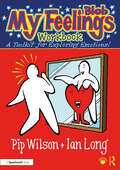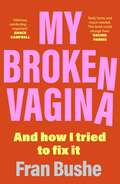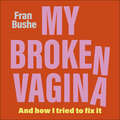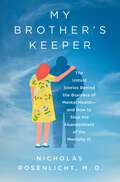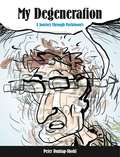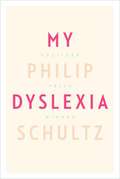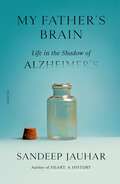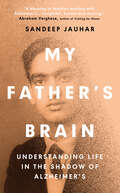- Table View
- List View
Mutagenic Impurities: Strategies for Identification and Control
by Andrew TeasdaleLearn to implement effective control measures for mutagenic impurities in pharmaceutical development In Mutagenic Impurities: Strategies for Identification and Control, distinguished chemist Andrew Teasdale delivers a thorough examination of mutagenic impurities and their impact on the pharmaceutical industry. The book incorporates the adoption of the ICH M7 guideline and focuses on mutagenic impurities from both a toxicological and analytical perspective. The editor has created a primary reference for any professional or student studying or working with mutagenic impurities and offers readers a definitive narrative of applicable guidelines and practical, tested solutions. It demonstrates the development of effective control measures, including chapters on the purge tool for risk assessment. The book incorporates a discussion of N-Nitrosamines which was arguably the largest mutagenic impurity issue ever faced by the pharmaceutical industry, resulting in the recall of Zantac and similar drugs resulting from N-Nitrosamine contamination. Readers will also benefit from the inclusion of: A thorough introduction to the development of regulatory guidelines for mutagenic and genotoxic impurities, including a historical perspective on the development of the EMEA guidelines and the ICH M7 guideline An exploration of in silico assessment of mutagenicity, including use of structure activity relationship evaluation as a tool in the evaluation of the genotoxic potential of impurities A discussion of a toxicological perspective on mutagenic impurities, including the assessment of mutagenicity and examining the mutagenic and carcinogenic potential of common synthetic reagents Perfect for chemists, analysts, and regulatory professionals, Mutagenic Impurities: Strategies for Identification and Control will also earn a place in the libraries of toxicologists and clinical safety scientists seeking a one-stop reference on the subject of mutagenic impurity identification and control.
Mutant (Dr. Richard Steele #1)
by Peter ClementFormer ER doctor Peter Clement blends electrifying human drama with the suspense of top-notch medical thrillers. With Mutant he has written one of his most gripping, utterly chilling novels to date. On an isolated stretch of highway in Oahu, a woman cradles her dying son in her arms. In the days that follow, an autopsy draws a shocking conclusion: the boy, his lungs filled with blood, died of a disease previously found only in birds. On the other side of the globe, Dr. Richard Steele, a burned-out ER doctor is being recruited into a movement to examine the hazards of genetically modified foods, a job that takes him to an explosive conference in Hawaii. Spearheaded by a charismatic female doctor, the anti-bioengineering movement is gathering steam. While a powerful company is using genetic breakthroughs to create disease-resistant super crops, activists warn that new DNA strains will wreak havoc on the environment. But no one suspects that the controversy is masking a far more frightening human threat-one that could lead to the deadliest weapon of mass destruction ever unleashed upon the world. . . .
Mutant p53 and MDM2 in Cancer
by Swati Palit Deb Sumitra DebThis book provides the readers with an overview of research on p53, which has been shown to play a role in numerous crucial biological pathways in normal and cancer cells. Leading scientist in the field, who have all made direct contributions to the understanding of the molecular events underpinning p53 function, have been invited to contribute the various chapters, which discuss the current knowledge of the signaling cascades that are activated by mutations in p53 and overexpression of MDM2, frequently found in human cancer and are major causes of oncogenesis. This book features chapters on the molecular basis of oncogenesis induced by gain of function mutation of p53, signaling pathways induced by MDM2 overexpression, control of mutant or wild-type p53 function by MDM2 and MDMX, p53 mutation in hereditary cancer and structural aspects that activate mutant p53 which can be targeted by drug therapy. This book should be useful for scientists at all levels.
Mutation
by Robin CookIn Mutation, Robin Cook's masterpiece of techno-medical suspense, Dr. Cook tells a story as chilling and real as today's headlines. <P><P> On the forefront of surrogate parenting and genetic research, it is the explosive tale of a brilliant doctor who sought to create the son of his dreams--and invented a living nightmare...
Mutual Accompaniment and the Creation of the Commons
by Mary WatkinsA landmark book that maps a radical model not only for the “helping” professions but for the work of solidarity This timely and pathbreaking volume maps a radical model of accompaniment, exploring its profound implications for solidarity. Psychosocial and ecological accompaniment is a mode of responsive assistance that combines psychosocial understanding with political and cultural action. Accompaniment—grounded in horizontality, interdependence, and potential mutuality—moves away from hierarchical and unidirectional helping-profession approaches that decontextualize suffering. Watkins envisions a powerful paradigm of mutual solidarity with profound implications for creating commons in the face of societal division and indifference to suffering.
Muziek en bewegen bij dementie
by Annemieke Vink Helma Erkelens Louwke MeinardiVeel van onze herinneringen zijn gekoppeld aan muziek. Dat geldt voor hoogtepunten als verliefd zijn en trouwen, en ook gebeurtenissen uit onze kindertijd zijn vaak verbonden met muziek. Het luisteren naar muziek levert voor mensen met dementie plezierige momenten op. Een bekende melodie als `Het dorp' van Wim Sonneveld bijvoorbeeld, brengt ze weer even terug in de tijd van toen.Muziek en bewegen bij dementie laat zien hoe je met eenvoudige middelen kunt bijdragen aan meer welbevinden en kwaliteit van leven: het zingen van een liedje tijdens het wassen, zachte muziek bij het opstaan, een dansje in de huiskamer, even naar buiten. Als praten niet meer kan, is nog wel contact mogelijk via muziek en bewegen.Dit boek is rijk gevuld met tips en voorbeelden voor verzorgenden, mantelzorgers en activiteitenbegeleiders, en beschrijft voor het management de wellicht benodigde omslag in denken en doen.Annemieke Vink (psycholoog) doceert Theorie muziektherapie aan het ArtEZ Conservatorium Enschede. Zij doet onder andere onderzoek naar de effecten van muziektherapie bij mensen met dementie. Helma Erkelens (historica) en Louwke Meinardi (socioloog) zijn freelance journalist/tekstschrijver en communicatieadviseur. Ze zijn beiden gespecialiseerd in zorg, met name in gezond en actief ouder worden en zorg voor ouderen.De tweede druk is inhoudelijk niet gewijzigd ten opzichte van de eerste druk.
My Age of Anxiety: Fear, Hope, Dread, and the Search for Peace of Mind
by Scott StosselA riveting, revelatory, and moving account of the author's struggles with anxiety, and of the history of efforts by scientists, philosophers, and writers to understand the condition <P><P>As recently as thirty-five years ago, anxiety did not exist as a diagnostic category. Today, it is the most common form of officially classified mental illness. Scott Stossel gracefully guides us across the terrain of an affliction that is pervasive yet too often misunderstood. Drawing on his own long-standing battle with anxiety, Stossel presents an astonishing history, at once intimate and authoritative, of the efforts to understand the condition from medical, cultural, philosophical, and experiential perspectives. <P><P>He ranges from the earliest medical reports of Galen and Hippocrates, through later observations by Robert Burton and Søren Kierkegaard, to the investigations by great nineteenth-century scientists, such as Charles Darwin, William James, and Sigmund Freud, as they began to explore its sources and causes, to the latest research by neuroscientists and geneticists. <P><P>Stossel reports on famous individuals who struggled with anxiety, as well as on the afflicted generations of his own family. His portrait of anxiety reveals not only the emotion's myriad manifestations and the anguish anxiety produces but also the countless psychotherapies, medications, and other (often outlandish) treatments that have been developed to counteract it. <P><P> Stossel vividly depicts anxiety's human toll--its crippling impact, its devastating power to paralyze--while at the same time exploring how those who suffer from it find ways to manage and control it. My Age of Anxiety is learned and empathetic, humorous and inspirational, offering the reader great insight into the biological, cultural, and environmental factors that contribute to the affliction.
My Beautiful Disaster: My Brain Injury, My Gift, My Life
by Derek AmatoDerek Amato's reflections in My Beautiful Disaster provide rare insight into what people with extraordinary gifts see, think, feel and do; pose questions about the potential to tap into previously undetected abilities and spotlight the 'silent epidemic' of head trauma. His experiences also make vivid some the challenges faced by those living with autism and other neurological disorders and hint at the possibility we all have more in common than we think. Readers enchanted by autistic savant, Daniel Tammet's eloquent Born On A Blue Day, will welcome another multi-layered, first person account of what is to live with a remarkable condition. Uniquely, having spent his life as a "neurotypical" Amato's tale relates the before and after of 'the gift'; his voice at times resonating with incredulity at what has happened and what the eventual cost may be.
My Beautiful Genome: Exposing Our Genetic Future, One Quirk at a Time
by Lone FrankWhat if you could predict your future - which political party you will vote for, what kind of person you will marry, which disease will end your life, whether your blue mood will fester into something more troubling, even debilitating. Would you want to know? Taking a uniquely intimate and cheeky approach to the personal genomics revolution, internationally acclaimed science writer Lone Frank swabs up her genetic code to explore who any of us are in the days when a catalogue of your full six billion DNA building blocks is available for $10,000 and the local Walgreens offers genetic screening tests to anyone. She challenges the august Nobel Prize winners and the hyperactive business mavericks who are pushing to map and decipher every fetus's genome within the next decade. She tests the potential to detect diseases early, as well as our capacity to develop chronic anxieties when our DNA is seen as a death sentence. She ponders whether personality, including her own above-average irritability and non-conformity, can really be reduced to biochemistry. And she prods the psychologists who hope to uncover just how much or how little our environment will matter in the new genetic century - a quest made all the more gripping as Frank considers her family's and her own struggles with depression. At turns compellingly candid and irreverently insightful, Frank provides the first truly personal account of the new science of consumer-led genomics - and to what extent our genes determine our destiny. Lone Frank is the author of The Neurotourist: Postcards from the Edge of Brain Science (ISBN 9781851687961). She holds a PhD in neurobiology and was previously a research scientist working in the biotechnology industry in the United States. An award-winning science journalist and TV documentary presenter, she has written for such publicationsn as Scientific American, Science, and Nature Biotechnology and is a frequent speaker at venues including Harvard Medical School, the Library of Congress, the Royal Society, and TED.
My Best Friend's Secret: a page-turning must-read debut thriller
by Emily FreudHow do you escape a past you can't remember?'Had me gripped from the start' 5* reader review'An outstanding debut' 5* reader review'Such a mega page-turner' 5* reader reviewKate Sullivan has a beautiful home, a job she loves and a handsome fiancé: all she'd ever dreamed of since getting sober and painstakingly piecing her life back together.But a chance encounter with her old best friend Becky threatens Kate's newfound and fragile happiness. Kate remembers nothing of their last drunken night out, the night Becky broke off their friendship without warning or explanation.With Becky back in her life, Kate is desperate to make amends for the past. For the closure she craves, Kate needs to know what she did that ruined everything. But what if the truth is worse than Kate could have imagined?'A clever tale of how our demons shape our lives' ALEXANDRA SHULMAN'Gut-wrenching and powerful' CHARLOTTE DUCKWORTH'Beautiful writing and devastating twists' MIRANDA SMITH'A real, clever page-turner. Dare I say addictive' TINA BAKER***Previously published as Closure***
My Best Friend's Secret: a page-turning must-read debut thriller
by Emily FreudHow do you escape a past you can't remember?'Had me gripped from the start' 5* reader review'An outstanding debut' 5* reader review'Such a mega page-turner' 5* reader reviewKate Sullivan has a beautiful home, a job she loves and a handsome fiancé: all she'd ever dreamed of since getting sober and painstakingly piecing her life back together.But a chance encounter with her old best friend Becky threatens Kate's newfound and fragile happiness. Kate remembers nothing of their last drunken night out, the night Becky broke off their friendship without warning or explanation.With Becky back in her life, Kate is desperate to make amends for the past. For the closure she craves, Kate needs to know what she did that ruined everything. But what if the truth is worse than Kate could have imagined?'A clever tale of how our demons shape our lives' ALEXANDRA SHULMAN'Gut-wrenching and powerful' CHARLOTTE DUCKWORTH'Beautiful writing and devastating twists' MIRANDA SMITH'A real, clever page-turner. Dare I say addictive' TINA BAKER***Previously published as Closure***
My Best Friend's Secret: a page-turning must-read debut thriller
by Emily FreudHow do you escape a past you can't remember?'Had me gripped from the start' 5* reader review'An outstanding debut' 5* reader review'Such a mega page-turner' 5* reader reviewKate Sullivan has a beautiful home, a job she loves and a handsome fiancé: all she'd ever dreamed of since getting sober and painstakingly piecing her life back together.But a chance encounter with her old best friend Becky threatens Kate's newfound and fragile happiness. Kate remembers nothing of their last drunken night out, the night Becky broke off their friendship without warning or explanation.With Becky back in her life, Kate is desperate to make amends for the past. For the closure she craves, Kate needs to know what she did that ruined everything. But what if the truth is worse than Kate could have imagined?'A clever tale of how our demons shape our lives' ALEXANDRA SHULMAN'A cracking debut' IRISH INDEPENDENT'Gut-wrenching and powerful' CHARLOTTE DUCKWORTH'[An] emotional page-turner' WOMAN'S WEEKLY'Beautiful writing and devastating twists' MIRANDA SMITH'A real, clever page-turner. Dare I say addictive' TINA BAKER***Previously published as Closure***(P)2020 Quercus Editions Limited
My Blob Feelings Workbook: A Toolkit for Exploring Emotions! (Blobs)
by Pip Wilson Ian LongMy Blob Feelings Workbook provides the reader with a series of unique visual reflective exercises that help to reveal one’s own emotional portrait. Using a combination of Blob characters and open questions, the reader can gradually build up an image of themselves across a wide range of ‘who I am’ subjects and real-life scenarios. Packed with well-loved blob illustrations, this book includes a wealth of downloadable pages and will enable the individual to ‘draw’ a picture of themselves emotionally through the series of exercises. Sections covered include: • My Charts • My Feeling Scales • My Scenarios • Myself Scales Best used as a personal toolkit for self-awareness, this book is also a rich resource for professionals working in the field of feelings to use with their own clients. It is suitable for all ages from secondary school upwards and ideal for individuals, couples, groups and all who wish to go deeper in understanding their emotional strengths and areas for development.
My Blob Feelings Workbook: A Toolkit for Exploring Emotions! (Blobs)
by Pip Wilson Ian LongMy Blob Feelings Workbook provides the reader with a series of unique visual reflective exercises that help to reveal one’s own emotional portrait. Using a combination of Blob characters and open questions, the reader can gradually build up an image of themselves across a wide range of ‘who I am’ subjects and real-life scenarios.Packed with well-loved blob illustrations, this book includes a wealth of downloadable pages and will enable the individual to ‘draw’ a picture of themselves emotionally through the series of exercises. Sections covered include: My Charts My Feeling Scales My Scenarios Myself Scales Best used as a personal toolkit for self-awareness, this book is also a rich resource for professionals working in the field of feelings to use with their own clients. It is suitable for all ages from secondary school upwards and ideal for individuals, couples, groups and all who wish to go deeper in understanding their emotional strengths and areas for development.
My Broken Vagina: One Woman's Quest to Fix Her Sex Life, and Yours
by Fran BusheThis book is one woman's funny, moving, and sometimes awkward quest to fix her sex life, but it's the story of millions of women everywhere - half of all women have felt pain during sex. During award-winning writer and performer Fran Bushe's journey towards building a better relationship with her genitals, doctors advised her to have a glass of wine to loosen up, and male friends suggested she simply hadn't 'tried' the right penis yet. Unsurprisingly, neither worked.After a visit to Sex Camp and many attempts to fix her 'broken' vagina, Fran decided to share her own hilarious, excruciating, and sometimes upsetting experiences. With the help of her 16 year old self's diary, expert advice, candid and enlightening interviews with others about sex, and some self-care exercises, Fran sets about trying to make herself, and other people, feel like they're not being gaslit by their own vaginas.
My Broken Vagina: One Woman's Quest to Fix Her Sex Life, and Yours
by Fran BusheThis book is one woman's funny, moving, and sometimes awkward quest to fix her sex life, but it's the story of millions of women everywhere - half of all women have felt pain during sex. During award-winning writer and performer Fran Bushe's journey towards building a better relationship with her genitals, doctors advised her to have a glass of wine to loosen up, and male friends suggested she simply hadn't 'tried' the right penis yet. Unsurprisingly, neither worked.After a visit to Sex Camp and many attempts to fix her 'broken' vagina, Fran decided to share her own hilarious, excruciating, and sometimes upsetting experiences. With the help of her 16 year old self's diary, expert advice, candid and enlightening interviews with others about sex, and some self-care exercises, Fran sets about trying to make herself, and other people, feel like they're not being gaslit by their own vaginas.
My Broken Vagina: One Woman's Quest to Fix Her Sex Life, and Yours
by Fran BusheA candid and hilarious conversation about what happens when sex doesn't feel like it's working.This book is one woman's funny, moving, and sometimes awkward quest to fix her sex life, but it's the story of millions of women everywhere - half of all women have felt pain during sex. During award-winning writer and performer Fran Bushe's journey towards building a better relationship with her genitals, doctors advised her to have a glass of wine to loosen up, and male friends suggested she simply hadn't 'tried' the right penis yet. Unsurprisingly, neither worked.After a visit to Sex Camp and many attempts to fix her 'broken' vagina, Fran decided to share her own hilarious, excruciating, and sometimes upsetting experiences. With the help of her 16 year old self's diary, expert advice, candid and enlightening interviews with others about sex, and some self-care exercises, Fran sets about trying to make herself, and other people, feel like they're not being gaslit by their own vaginas. (P) 2021 Hodder & Stoughton Ltd
My Brother's Keeper: The Untold Stories Behind the Business of Mental Health—and How to Stop the Abandonment of the Mentally Ill
by Nicholas RosenlichtA leading psychiatrist seeks to transform our understanding of mental health care and how it fits into larger social and economic forces—and proposes an effective and compassionate new framework for healing.Mental health care in America has become nothing short of atrocious. Supposed developments in treatment methods and medication remain inaccessible to those who need them most. Countless people seeking treatment are routinely funneled into prison or end up homeless while an epidemic of mental illness ravages younger generations. It seems obvious that the system is broken, but the tragic truth is that it is actually functioning exactly as intended, providing reliably enormous profits for the corporate entities who now manage mental health care. It is easy to turn a blind eye. Most of us are more comfortable ducking our own fears about mental health and placing our faith in the rugged American individual and the free market, rather than confronting our own prejudices and misguided beliefs. Why did we choose to build such a disastrous system when every other industrialized nation has developed far better models? After decades of work in psychiatry, Dr. Nicholas Rosenlicht reveals how and why we arrived at this abysmal reality—and more importantly, how we can find our way out of it. Timely and unflinching, and written with commanding prose and the deep knowledge of a mental health care veteran who categorically rejects corporate interests, Dr. Rosenlicht makes plain the disastrous outcomes of the for-profit mental health care model. Patients are &“clients&” and doctors are &“providers,&” stripping away the human element and emboldening shifty ethical and legal practices. Perhaps most insidious, the business model paints the mentally ill as the &“other,&” as people who just don&’t want help, rather than as people who can&’t afford care or even realize they need help as a consequence of their illness. But a path forward does exist. Mental illness is something that will touch all of us all of us in some way, if not directly through those we know and love. Those who have already helped care for a loved one know that those who suffer by it have hopes, desires, and aspirations. A healthy solution means a healthier society. In the tradition of Andrew Solomon or Bessel van der Kolk's The Body Keeps the Score, My Brother's Keeper is a paradigm shifting book that can help us find our way to real and lasting solutions.
My Degeneration: A Journey Through Parkinson’s (Graphic Medicine #3)
by Peter Dunlap-ShohlHow does one deal with a diagnosis of Parkinson’s disease at the age of forty-three? My Degeneration, by former Anchorage Daily News staff cartoonist Peter Dunlap-Shohl, answers the question with humor and passion, recounting the author’s attempt to come to grips with the “malicious whimsy” of this chronic, progressive, and disabling disease. This graphic novel tracks Dunlap-Shohl’s journey through depression, the worsening symptoms of the disease, the juggling of medications and their side effects, the impact on relations with family and community, and the raft of mental and physical changes wrought by the malady. My Degeneration examines the current state of Parkinson’s care, including doctor/patient relations and the repercussions of a disease that, among other things, impairs movement, can rob patients of their ability to speak or write, degrades sufferers’ ability to deal with complexity, and interferes with the sense of balance. Readers learn what it’s like to undergo a dramatic, demanding, and audacious bit of high-tech brain surgery that can mysteriously restore much of a patient’s control over symptoms. But My Degeneration is more than a Parkinson’s memoir. Dunlap-Shohl gives the person newly diagnosed with Parkinson’s disease the information necessary to cope with it on a day-to-day basis. He chronicles the changes that life with the disease can bring to the way one sees the world and the way one is seen by the wider community. Dunlap-Shohl imparts a realistic basis for hope—hope not only to carry on, but to enjoy a decent quality of life.
My Dyslexia
by Philip SchultzDespite winning the Pulitzer Prize for Poetry in 2008, Philip Schultz could never shake the feeling of being exiled to the "dummy class" in school, where he was largely ignored by his teachers and peers and not expected to succeed. <P><P>Not until many years later, when his oldest son was diagnosed with dyslexia, did Schultz realize that he suffered from the same condition. <P>In his moving memoir, Schultz traces his difficult childhood and his new understanding of his early years. In doing so, he shows how a boy who did not learn to read until he was eleven went on to become a prize-winning poet by sheer force of determination. <P> His balancing act ”life as a member of a family with not one but two dyslexics, countered by his intellectual and creative successes as a writer ”reveals an inspiring story of the strengths of the human mind.
My Father's Brain: Life in the Shadow of Alzheimer's
by Sandeep JauharNamed a best book of the year by The New Yorker | A Smithsonian top ten science book of 2023 | One of AARP magazine's favorite books of 2023“Blending the humor, compassion, and absorbing family drama of first-rate memoir with expert science writing, [Sandeep Jauhar] has composed a can’t-miss introduction to what has been called the Age of Alzheimer’s.” —Sanjay Gupta, author of Keep Sharp and World War CA deeply affecting memoir of a father’s descent into dementia, and a revelatory inquiry into why the human brain degenerates with age and what we can do about it.Almost six million Americans—about one in every ten people over the age of sixty-five—have Alzheimer’s disease or a related dementia, and this number is projected to more than double by 2050. What is it like to live with and amid this increasingly prevalent condition, an affliction that some fear more than death? In My Father’s Brain, the distinguished physician and author Sandeep Jauhar sets his father’s struggle with Alzheimer’s alongside his own journey toward understanding this disease and how it might best be coped with, if not cured.In an intimate memoir rich with humor and heartbreak, Jauhar relates how his immigrant father and extended family felt, quarreled, and found their way through the dissolution of a cherished life. Along the way, he lucidly exposes what happens in the brain as we age and our memory falters, and explores everything from ancient conceptions of the mind to the most cutting-edge neurological—and bioethical—research. Throughout, My Father’s Brain confronts the moral and psychological concerns that arise when family members must become caregivers, when children’s and parents’ roles reverse, and when we must accept unforeseen turns in our closest relationships—and in our understanding of what it is to have a self. The result is a work of essential insight into dementia, and into how scientists, caregivers, and all of us in an aging society are reckoning with the fallout.
My Father's Brain: Understanding Life in the Shadow of Alzheimer's
by Sandeep JauharA son's journey through his father's dementia. As a cardiologist, Sandeep Jauhar is trained to think logically and dispassionately about medical problems, and primed to offer his patients reassurance and solutions. But when his father is diagnosed with Alzheimer&’s there are no magic treatments or miracle drugs – only the promise of unstoppable decline. For years Jauhar watches his father undergo a distressing transformation. Once a prominent research geneticist and author, he now repeats questions over and over, forgets what he has eaten for breakfast, makes baffling financial decisions and turns into a liability behind the wheel. Jauhar investigates the science of dementia and what actually happens in the brain as we age and our memory falters, uncovering the history of Alzheimer&’s from first discovery to the most cutting-edge research, and whether modern treatments offer any hope in a global crisis. A blend of science, history and memoir, My Father&’s Brain is a brutally honest and moving account of how Jauhar and his siblings grappled every day with some of life&’s toughest questions.
My Five Senses
by Aliki<P>A child's world is one filled with the discovery of sensations, and "My Five Senses" captures the excitement and wonder that accompany these discoveries by focusing on such common sensations as licking ice cream, petting a bunny and hearing a fire engine. <P>[This text is listed as an example that meets Common Core Standards in English language arts for K-1 at http://www.corestandards.org.]
My Glory Was I Had Such Friends: A Memoir
by Amy SilversteinIn this moving memoir about the power of friendship and the resilience of the human spirit, Amy Silverstein tells the story of the extraordinary group of women who supported her as she waited on the precipice for a life-saving heart transplant.Nearly twenty-six years after receiving her first heart transplant, Amy Silverstein’s donor heart plummeted into failure. If she wanted to live, she had to take on the grueling quest for a new heart—immediately.A shot at survival meant uprooting her life and moving across the country to California. When her friends heard of her plans, there was only one reaction: “I’m there.” Nine remarkable women—Joy, Jill, Leja, Jody, Lauren, Robin, Valerie, Ann, and Jane—put demanding jobs and pressing family obligations on hold to fly across the country and be by Amy’s side. Creating a calendar spreadsheet, the women—some of them strangers to one another—passed the baton of friendship, one to the next, and headed straight and strong into the battle to help save Amy’s life.Empowered by the kind of empathy that can only grow with age, these women, each knowing Amy from different stages of her life, banded together to provide her with something that medicine alone could not. Sleeping on a cot beside her bed, they rubbed her back and feet when the pain was unbearable, adorned her room with death-distracting decorations, and engaged in their “best talks ever.” They saw the true measure of their friend’s strength, and they each responded in kind.My Glory Was I Had Such Friends is a tribute to these women and the intense hours they spent together—hours of heightened emotion and self-awareness, where everything was laid bare. Candid and heartrending, this once-in-a-lifetime story of connection and empathy is a powerful reminder of the ultimate importance of “showing up” for those we love.
My Health
by Rebecca J. DonatelleThis book delivers the latest in personal health, including a new mindfulness theme where research on the benefits of mindfulness practices and the tools to incorporate them in all aspects of health are included in new modules. The book’s modular organization allows students to focus on learning the core material they need to know, while Learning Outcomes and review questions provide immediate feedback on what they’ve learned, allowing them to customize their study plan. Meanwhile, a concise text and a comprehensive supplements package allow instructors to zero in on what students need―without the jargon―making personal health courses more rewarding.
